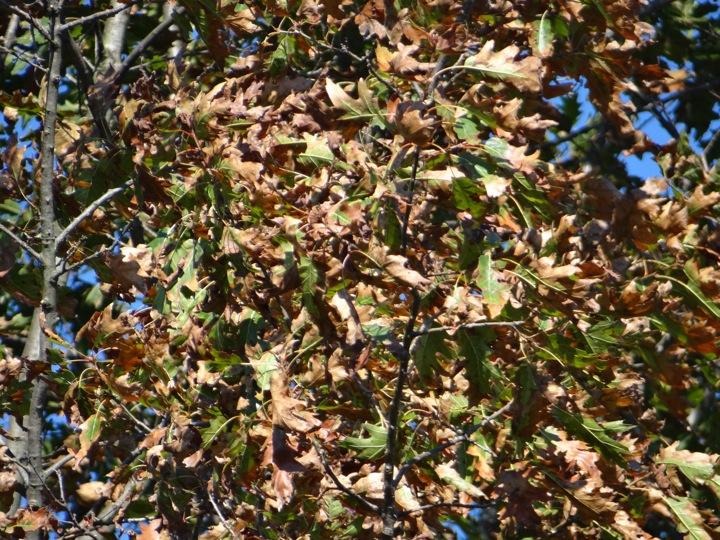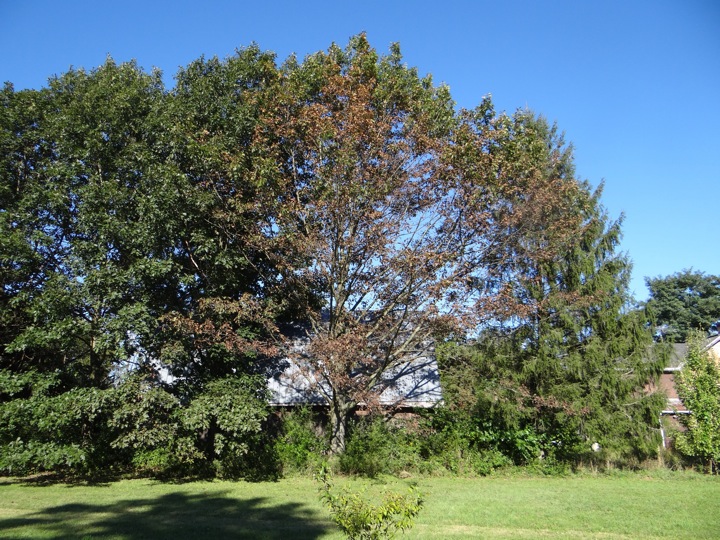When looking for a grand shade tree, the advice has usually been to choose a hardy, slow growing tree that will develop strong branching and provide a legacy for the future. Sadly, so many of these great trees are being affected by an onslaught of insects and diseases either foreign or home grown. A case in point is Oak Wilt which is affecting oaks and related species, killing thousands yearly. Most likely to contract the disease are the red oaks which includes the Shumard and Pin oaks. The red oaks are faster growing members of the oak family and can boast attractive red coloration in the fall which has made them popular choices for larger yards. Wilt also affects the White and Bur oaks , but not as frequently. The disease can also be transmitted to chestnut trees in the vicinity.
Oak wilt may have been busily killing trees since the 1890’s, but didn’t appear as a scientific disease description until the 1940’s. There is some argument that the disease may simply be more readily recognized now, having been present in the area for a long time, but other data gives the indication that the disease may be spreading. The culprit is a fungus, Ceratocystis fagacearum, which enters tree wounds and gums up the water carrying capacity of the tree in its xylem veins causing the wilting. It can spread via beetles who feed on the sap rich spore mats under the bark, carrying the spores to new oak tree victims in the near vicinity. The other mode of local spread is through the roots of the infected tree which may have formed natural grafts with their oak neighbors, providing a highway for the disease transmission. Long distance spread is thought to be from firewood/log cutting transport.
 The signs of the disease start at the top as the leaves turn brown at the margins and start to fall while still retaining some green coloration.
The signs of the disease start at the top as the leaves turn brown at the margins and start to fall while still retaining some green coloration.
These photos were taken of an oak tree at my property border. It is part of a group of three red oaks planted in a line right on the property border when the previous owner subdivided my farm’s property. They were likely planted to demarcate the border in the 1970’s.
Then twigs and branches die. At worst case, tree death can occur in weeks, some slowly decline over a matter of a few years and a few may recover. The outlook for oak trees with the disease isn’t pretty.
I first noticed last summer that this oak wasn’t looking healthy, but it has progressed to this point in a year. Another oak in the group is starting to show symptoms, but the red oak in the center is still healthy. This property is currently vacant and whoever purchases it will have large dead oak trees to deal with.
Treatment options recommend immediately trenching and separating the diseased oak from any related neighbors to cut the root grafts. Generally the dead tree must be disposed of by removal and burning. There are some strong chemical poisons that may be halt the disease in a prized tree if an early diagnosis is made. Regardless, it’s an expensive proposition to cut down and remove a large oak tree felled by this insidious fungus. Luckily for Carroll County, most instances of Oak Wilt are reported in Allegheny and Garrett Counties; perhaps we have more white oaks in our area. But, these pictures are from the county just north of us in Pennsylvania (Adams), so it could well become a future problem.



